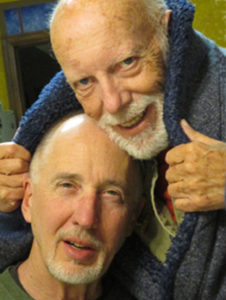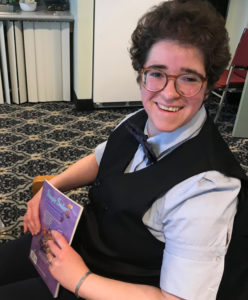Pronouns, pronouns everywhere! For many trans and genderqueer folks, changing pronouns is an early step in social transition. Problem is, I can’t decide which ones to use, or how to communicate them in a low-key way that doesn’t make me feel self-conscious. I worry that queerness is being co-opted to make me buy stuff. The paradox of being on the gender frontier is that the desire for authenticity pushes me to become a fashion clone in order to be read correctly by others. Button-down shirt, short asymmetrical hairdo, large plastic-framed eyeglasses, tattoo, and anime-patterned fanny pack: the enby uniform.
Since I am ultimately a sucker for bling, I will recommend Etsy as a good source of cute pronoun jewelry. This customizable necklace (currently sold out) from Spacerobot Studio holds several colorful half-inch-square signs that you can flip over to indicate which pronoun you’re using that day. (Shane always flips mine to “rainbow question mark”. The kid understands me.) Gender Gems are a popular alternative.
“They” is catching on as the default gender-inclusive pronoun, as it’s already a common English word that everyone can pronounce. But it feels too neuter for me, and I get confused by the singular/plural shifts. (Just for myself–of course I’ll make the effort for anyone else who uses “they”.) I suspect I really want to use “he/him”, and I’m just prematurely fatigued and anxious about not being believed as a “man” because I don’t bind my breasts or take hormones.
In a recent interview in First Person Plural Harlem, fiction writer and queer podcaster Dennis Norris II made the most compelling case for me to try out “they” pronouns. Originally identifying as a gay man, Norris talks about coming out as nonbinary:
I’ve recently adopted the gender neutral pronoun They as my preferred pronoun, after much consideration. Although I’m perfectly happy to answer to She or He. I’ve given this much thought and for me it has to do with the fact that I contain multitudes across an array of layers. There are a few, very loving, very well-meaning people in my life who are having trouble adjusting to my use of the word They because of the notion that it’s grammatically incorrect. But for me, it’s actually grammatically perfect because while I am only one person, I feel as though in this area of my existence I have multiple identities. Or perhaps spirits better personifies this. Multiple spirits. And so I need a pronoun that reflects multiplicity. But in this, I also feel very singularly and staunchly me, myself. I. Because this is me I’m talking about, and no one else. Not sure if that makes sense to anyone else but it does to me.
Norris is co-host of the brilliantly smutty literary podcast Food 4 Thot, author of a short story chapbook from Awst Press, and this year’s guest judge for our Winning Writers Tom Howard/John H. Reid Fiction & Essay Contest.
Fashion magazines are becoming more politically conscious these days, as we saw from Teen Vogue’s coverage of sexism under the Tan Dumplord administration. In this April 12 article from Allure, Katelyn Burns observes that “Navigating Beauty Standards as a Trans Woman Is an Impossible Balancing Act”. When trans women don’t go out in full high-femme makeup and clothing, they’re mocked for not “trying hard enough” to pass. But if they do put on the Ritz, they get criticized by cis feminists for being artificial and perpetuating stereotypes of femininity. Burns comments sardonically: “Sometimes I know I’m a real woman because everyone has an unsolicited opinion about my appearance.”
Gatekeeping, judgmentalism, fundamentalism–sometimes it seems we escaped these pathologies in our religious institutions and families, only to replicate them in our progressive, feminist, or queer spaces. This is why, in a July 2017 article on the lesbian culture blog Autostraddle, Frances Lee says: “Excommunicate Me From the Church of Social Justice”. They see disturbing similarities between their new community and the evangelical church they left behind: the quest for absolute purity, the elevation of unquestionable sacred texts, preaching and punishment as relational styles, and the reproduction of colonialist logics.
Postcolonialist black Caribbean philosopher Frantz Fanon in his 1961 book Wretched of the Earth writes about the volatile relationship between the colonizer and the colonized, and the conditions of decolonization. In it, he sharply warns the colonized against reproducing and maintaining the oppressive systems of colonization by replacing those at top by those previously at the bottom after a successful revolution.
As a QTPOC (queer, trans person of color), I have experienced discrimination and rejection due to who I am. I have sought out QTPOC-only spaces to heal, find others like me, and celebrate our differences. Those spaces and relationships have saved me from despair time and time again. And yet, I reject QTPOC supremacy, the idea that QTPOCs or any other marginalized groups deserve to dominate society. The experiences of oppression do not grant supremacy, in the same way that being a powerful colonizer does not. Justice will never look like supremacy. I wish for a new societal order that does not revolve around relations of power and domination.
Lee expresses the intention to reorient their activism and community-building towards “crafting alternative futures where we don’t have to fight each other for resources and care.” (Hat tip to the anti-racist organization White Awake for this link.)
Along similar lines, in an article from April on the website Selfish Activist, somatic therapist Tada Hozumi asks an important and unusual question: “How Do Our Allies Deserve to Be Treated?” (Hat tip to Little Red Tarot for this link.) Hozumi compassionately notes that the much-discussed “white fragility” (ego defenses against acknowledging race and racism) may have a surface appearance of pride and entitlement, but underneath are shame and vulnerability that deserve respectful handling:
Allies deserve that we recognize our influence over them.
By default, allies come to allyship with shame, even disgust for themselves and the people they represent.
This is because allies come to allyship through surrender.
They are in a tender place where they feel like their ideas about equity in the world have been shattered and whatever they do cannot make up for the historical atrocities that have been committed in their name (which is true).
It is not in the spirit of healthy relationship to treat this surrender as submission that is worthy of domination.
Within the intimate container of allyship, we hold the seat of influence.
Of course, in the larger context of our culture, our allies will always be the ones who hold more privilege and influence.
The reality that our allies are power-full and power-less is a deep paradox of allyship as a relationship…
…Following the above, our allies deserve that we respect their surrender and do not manipulate them.
This is not an opportunity for us to project and inflict them with emotions that they cannot possibly individually responsible for.
Allies are not here to satisfy our wounds from the past including our ancestral and childhood wounds. They are here to serve liberation with our guidance, not to be abused in turn for what their people have done.
It was really validating for me to see this dynamic named in the article, because this kind of trauma reenactment made most of the social justice conversations in my college and grad school years too toxic to be valuable.
Social worker and racialized trauma expert Resmaa Menakem proposes “White Supremacy as a Trauma Response” in this April article on Medium. Trauma is a bodily response before it’s an emotional state. It’s an unconsciously learned pattern of physiological reactions that had survival value for us or our ancestors.
In many cases, the body gets stuck in freeze mode, and then develops strategies around this “stuckness,” including extreme reactions, compulsions, strange likes and dislikes, seemingly irrational fears, and unusual avoidance strategies. Over time, these can become embedded in the body as standard ways of surviving and protecting itself. When these strategies are repeated and passed on over generations, they can become the standard responses in individuals, families, communities, and cultures.
All of this describes trauma in general — and white supremacy in particular.
To undo racism, Menakem suggests, “people of all skin tones, but especially folks with white bodies… need to begin with our bodies, and with the healing of our trauma.”



